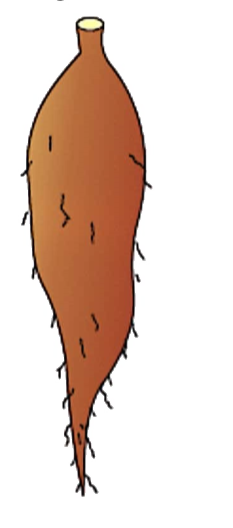A fibrous roots system is efficient in
(a) Food Storage
(b) Nitrogen fixation
(c) Good anchorage
(d) Absorption for deep soil layers
Food Storage
Nitrogen fixation
Good anchorage
Absorption for deep sail layers.
The correct Answer is:C
To solve the question regarding the efficiency of a fibrous root system, we need to analyze each option provided:
1. Understanding Fibrous Root System: A fibrous root system consists of numerous thin roots that spread out in various directions from the base of the plant. This structure is different from a taproot system, which has one main root.
2. Analyzing the Options:
- (a) Food Storage: Fibrous roots are not primarily designed for storing food. They are more focused on absorption and anchorage.
- (b) Nitrogen Fixation: While some plants can fix nitrogen, fibrous roots themselves do not play a significant role in this process. Nitrogen fixation is more commonly associated with specific plants like legumes that have specialized root nodules.
- (c) Good Anchorage: Fibrous roots are very effective at anchoring the plant in the soil due to their extensive network. This allows the plant to remain stable and upright, especially in windy conditions.
- (d) Absorption for Deep Soil Layers: Fibrous roots generally do not penetrate deeply into the soil. Instead, they are more effective at absorbing moisture and nutrients from the upper layers of soil.
3. Conclusion: Based on the analysis, the option that best describes the efficiency of a fibrous root system is (c) Good anchorage. This is because the diverse and widespread nature of fibrous roots provides excellent stability for the plant.
- (a) Food Storage: Fibrous roots are not primarily designed for storing food. They are more focused on absorption and anchorage.
- (b) Nitrogen Fixation: While some plants can fix nitrogen, fibrous roots themselves do not play a significant role in this process. Nitrogen fixation is more commonly associated with specific plants like legumes that have specialized root nodules.
- (c) Good Anchorage: Fibrous roots are very effective at anchoring the plant in the soil due to their extensive network. This allows the plant to remain stable and upright, especially in windy conditions.
- (d) Absorption for Deep Soil Layers: Fibrous roots generally do not penetrate deeply into the soil. Instead, they are more effective at absorbing moisture and nutrients from the upper layers of soil.
Topper's Solved these Questions
- ROOTBOOK - DINESH PUBLICATION ENGLISHCHAPTER - ROOTEXERCISE - REVISION QUSTIONS FROM COMPETITIVE EXAMS.
52 Videos
- ROOTBOOK - DINESH PUBLICATION ENGLISHCHAPTER - ROOTEXERCISE - Assertion
2 Videos
- RESPIRATIONBOOK - DINESH PUBLICATION ENGLISHCHAPTER - RESPIRATIONEXERCISE - CHECK YOUR GRASP
20 Videos
- SEEDSBOOK - DINESH PUBLICATION ENGLISHCHAPTER - SEEDSEXERCISE - CHECK YOUR GRASP
10 Videos
Similar Questions
Knowledge Check
In lichen, the fungus provides
(a) protection, anchorage and absorption for algae
(b) food for alga
(c) oxygen for alga
(d) fixes nitrogen for algaAprotection, anchorage and absorption for algaeBfood for algaCoxygen for algaDfixes nitrogen for alga
Which kind of modification is seen in the given diagram?

(a) Tap root for storage
(b) Adventitious roots for supports
(c) Adventitious root for storage
(d) Tap root for respiration
View SolutionWhich of the following is not the function of stem? (a) Storage of food (b) Provides support (c) Conduction of minerals (d) Vegetative propagation (e) Absorption of minerals
View SolutionRead the following statements w.r.t. functions of the roots. (a) Absorption of water and minerals. (b) Conduct organic substances to plant parts. (c) Provides anchorage to plant parts. (d) Stores reserve food material. (e) Synthesize plant growth hormones.
View SolutionThe principle by which blotting paper absorbs water is
(a) Capillary action
(b) Transpiration pull
(c) Root pressure
(d) Absorptive capacity
View SolutionTranspiration has more than one purpose. Which of the following is not the purpose of transpiration?
(a) Creates transpiration pull for absorption and transport in plants.
(b) Cools leaf surfaces by evaporative cooling
(c) Transports minerals from the soil to all parts of the plant.
(d) Gives high tensile strength to water column present in xylem.
(e) Translocation of sucrose from source to sink
View SolutionGiven below are assertion and reason. Point out if both are correct with reason being correct explanation (A), both true but reason is not correct explanation (B), assertion true but reason is wrong (C), both are wrong (D). Assertion. Thick layers of muscles are present in the wall of alimentary canal. Reason. These muscles help in mixing of food materials with enzymes coming from glands of alimentary canal.Â
View SolutionThe main functions of the root systems are
(a) Absorption of water & minerals
(b) Providing a proper anchorage to the plant
(c) Maintaining the temperature & pressure of the plant
(d) Gaseous exchange
View Solution